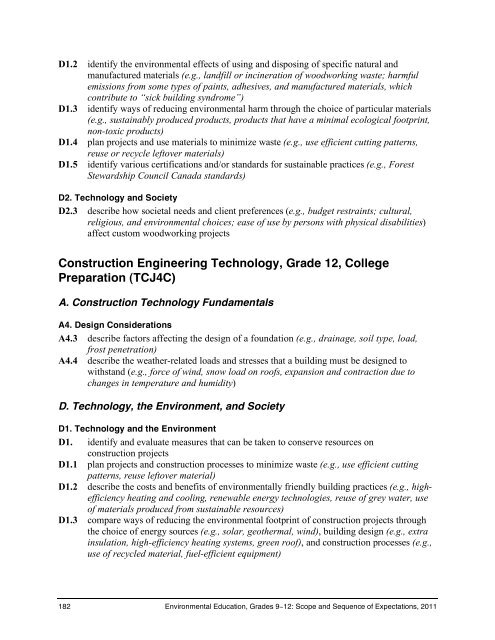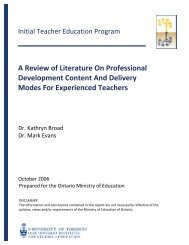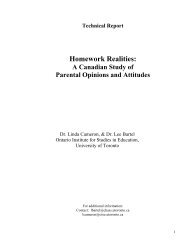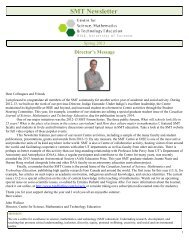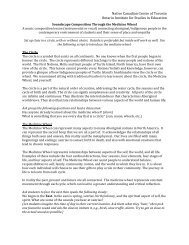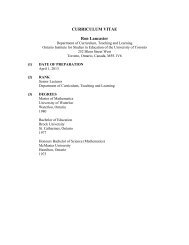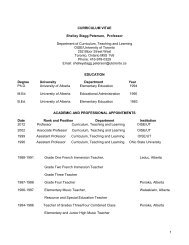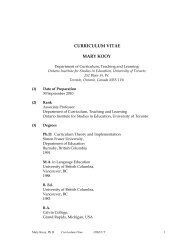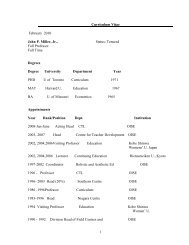The Ontario Curriculum, Grades 9-12 - Ministère de l'éducation ...
The Ontario Curriculum, Grades 9-12 - Ministère de l'éducation ...
The Ontario Curriculum, Grades 9-12 - Ministère de l'éducation ...
You also want an ePaper? Increase the reach of your titles
YUMPU automatically turns print PDFs into web optimized ePapers that Google loves.
D1.2 i<strong>de</strong>ntify the environmental effects of using and disposing of specific natural and<br />
manufactured materials (e.g., landfill or incineration of woodworking waste; harmful<br />
emissions from some types of paints, adhesives, and manufactured materials, which<br />
contribute to “sick building syndrome”)<br />
D1.3 i<strong>de</strong>ntify ways of reducing environmental harm through the choice of particular materials<br />
(e.g., sustainably produced products, products that have a minimal ecological footprint,<br />
non-toxic products)<br />
D1.4 plan projects and use materials to minimize waste (e.g., use efficient cutting patterns,<br />
reuse or recycle leftover materials)<br />
D1.5 i<strong>de</strong>ntify various certifications and/or standards for sustainable practices (e.g., Forest<br />
Stewardship Council Canada standards)<br />
D2. Technology and Society<br />
D2.3 <strong>de</strong>scribe how societal needs and client preferences (e.g., budget restraints; cultural,<br />
religious, and environmental choices; ease of use by persons with physical disabilities)<br />
affect custom woodworking projects<br />
Construction Engineering Technology, Gra<strong>de</strong> <strong>12</strong>, College<br />
Preparation (TCJ4C)<br />
A. Construction Technology Fundamentals<br />
A4. Design Consi<strong>de</strong>rations<br />
A4.3 <strong>de</strong>scribe factors affecting the <strong>de</strong>sign of a foundation (e.g., drainage, soil type, load,<br />
frost penetration)<br />
A4.4 <strong>de</strong>scribe the weather-related loads and stresses that a building must be <strong>de</strong>signed to<br />
withstand (e.g., force of wind, snow load on roofs, expansion and contraction due to<br />
changes in temperature and humidity)<br />
D. Technology, the Environment, and Society<br />
D1. Technology and the Environment<br />
D1. i<strong>de</strong>ntify and evaluate measures that can be taken to conserve resources on<br />
construction projects<br />
D1.1 plan projects and construction processes to minimize waste (e.g., use efficient cutting<br />
patterns, reuse leftover material)<br />
D1.2 <strong>de</strong>scribe the costs and benefits of environmentally friendly building practices (e.g., highefficiency<br />
heating and cooling, renewable energy technologies, reuse of grey water, use<br />
of materials produced from sustainable resources)<br />
D1.3 compare ways of reducing the environmental footprint of construction projects through<br />
the choice of energy sources (e.g., solar, geothermal, wind), building <strong>de</strong>sign (e.g., extra<br />
insulation, high-efficiency heating systems, green roof), and construction processes (e.g.,<br />
use of recycled material, fuel-efficient equipment)<br />
182 Environmental Education, <strong>Gra<strong>de</strong>s</strong> 9−<strong>12</strong>: Scope and Sequence of Expectations, 2011


